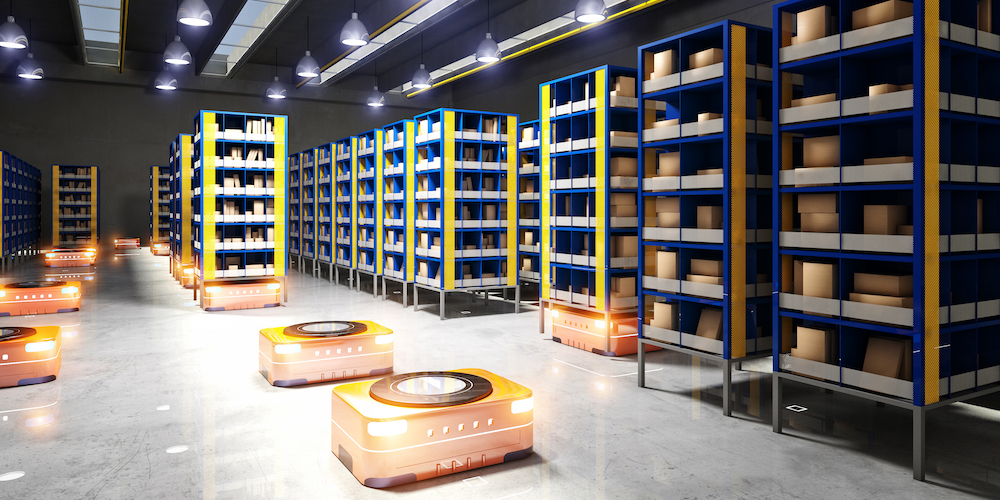
With continued pressure on the fulfillment industry from unabated e-commerce growth, warehouse managers struggle to contain costs while handling an ever-increasing workload. They are pressured to process more SKUs on tighter deadlines. With record low unemployment and increasing wages, more online vendors and third-party logistics firms are embracing warehouse automation as the only viable way forward.
Because labor accounts for 50% or more of the total cost of fulfilling an order, automating the least efficient aspect of labor activity—item picking—yields the greatest increases in efficiency and ROI. In a traditional warehouse, a picker can walk up to several miles a day retrieving items from shelves, placing them in totes and delivering the orders to be packed and shipped.
“Goods-to-person” systems eliminate this wasteful activity by automatically delivering items to a stationary picking station. Utilizing software that tells pickers which items to choose, these systems can substantially increase the productivity of workers while drastically reducing picking errors at the same time. Traditional GTP systems, known as automatic storage and retrieval systems (AS/RS), are usually large vertical carousels or lattices where goods are stored. Automatic shuttles and conveyors move the goods to the picking station.

A traditional goods-to-person system.
These systems are efficient, but they cost millions of dollars and require re-engineering the entire warehouse. Implementing them can take months if not years and positive ROI lags behind that. As a result, the “heavy iron” of large-scale fixed goods-to-person automation is not a viable solution for many warehouses.
The next evolution of goods-to-person was ushered in by replacing fixed AS/RS infrastructure with autonomous mobile robots or AMRs. Robotics vendors began using technologies like LIDAR, advanced sensors, and machine learning software to deploy robots which can move about a warehouse, avoid obstacles, deliver to a picking station, and even go to a recharging station to recharge themselves when their batteries run down.

Early AMRs moved shelves to the picking station.
The first iteration of AMRs, typically required replacing fixed shelving with four-sided “towers.” The brick-shaped robots go under, lift up and move these towers around the warehouse. The robots literally take the shelves to the person rather than the person going to the shelves. Despite its ingenuity, this still requires a complete reconfiguration of the warehouse – a major investment.
A new generation of AMRs followed that works within existing warehouse environments, large and small. The advantages of these robots are many: low up-front costs, quick deployment, and flexible capacity. Warehouses can increase the number of robots during peak shopping seasons and reduce the number as demand drops.
A problem still remained to be solved, though. Most of these mobile, cheaper robots do not deliver the increased productivity of a goods-to-person solution. They are, rather, a person-to-goods solution that still requires people walking the warehouse aisles. The robots merely help them pick the right order and transport it back to the picking station.
Finally, there is now a mobile, economic robotics system that represents a true goods-to-person solution that can be deployed in any warehouse with any configuration – quickly. The inVia Robotics solution includes robots equipped with an extensible platform and an arm with suction cups that can actually locate a specific bin or tote on a shelf, remove the tote, and carry it back to a stationary picker. The resulting increase in worker productivity can be as much as 500%.

inVia’s Picker robots rolling through a warehouse.
inVia’s robots require no up-front investment and can be deployed in a matter of days in most any of the 70,000 warehouses in the U.S. that currently have no form of automation. This flexible “Robotics as a Service” (RaaS) model enables any warehouse manager to increase efficiency, reduce costs, and match capacity with demand in real-time. The cost of using the robots is tied directly to the volume of order fulfillment. inVia’s RaaS solution is state-of-the-art for goods-to-person automation and can help warehouses quickly adapt to meet the ever-increasing demands of today’s customers.
To learn more about how inVia is powering the future of warehouse productivity, download our free eBook: “Robotics as a Service: The Fastest Path to Warehouse Automation”